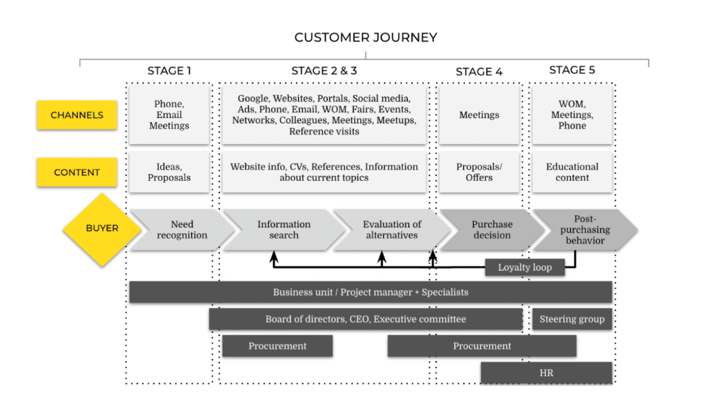-1.jpeg?width=1280&height=720&name=61a37f34a74e5e2ed29abda9_61a0a06512b50540fafe7283_drew-beamer-Vc1pJfvoQvY-unsplash%20(1)-1.jpeg)
To explain the importance of working with the customer journey, we first need to explain what a customer journey is.
In summary, a customer journey is a representation of a consumer's journey from having a need or problem, through the time of purchase to experiences and interactions thereafter. That is, a consumer's experiences before, during and after the time of purchase.
It can then be communicated in several different ways, but the most common is visually in a so-called 'customer journey map'.

Clever, right?
But here's the best part: the real benefit of customer journeys is that they force you and your business to look at the buying decision through the eyes of the customer!
It's the best way to get an overview of all interactions between customers and your business - from the first contact until a deal is closed... and beyond.
Only by doing so can you start making improvements in your sales, marketing and customer experience.
Want to read more about what a customer journey is? Read our post "What is a customer journey and customer journey map?".
Why Amazon and Starbucks care about customer journeys...
And why you should too.
These days, we're all so picky. When I come into contact with a company where, for example, I can't easily find the right information on their website, I get easily annoyed.
To be fair, maybe I shouldn't always be. Unconsciously, I compare the experience of this often small company to what I've come to expect from industry leaders like Amazon, Apple & Uber.
But that's the reality...
The hard truth is that the consumer doesn't care that you're not Amazon.
Unreasonably, they will still expect an equivalent experience across all touchpoints.
It's simply a case of getting on with it and rolling up your sleeves.
Providing a great customer experience isn't a nice-to-have option - it's a must-have.
If Company A's service costs the same as Company B's, but Company A has a website that doesn't answer the customer's questions easily, has a lower level of service or is difficult to contact, most people will choose to spend their money with Company B.
We can all agree on that but creating a positive customer experience is easier said than done.
The explosion of connected technology has changed consumer buying behavior. The buying journey used to be more static. It was a bit more straightforward, companies had more control over their relationships and the information about the company's services and products that was shared with customers was also easier to control.
Now the terrain looks different. Consumers can get information about a company in a way that was simply not possible just two decades ago.
Those who have grown up in this new reality will be even more demanding than you and me.
The multitude of touchpoints and pathways into the modern enterprise makes it extra challenging to offer a high-quality customer experience.
Company A in our previous example, without looking into it, has no idea why they are losing customers! They are flailing around blindly without getting any closer to the truth.
Yet another trend is affecting this.
For consumers (and clients too, for that matter), it's no longer just about how well a product or service performs. Increasingly, its presentation and the overall experience are becoming more important.
And to deliver this, you need to understand how your customers make a buying decision.
Understanding the customer journey is now more important than ever

Source: Salesforce
Think about the last time you needed something more complicated in your life than a carton of milk. Don't think about meaningful things like purpose, friendship and love. Think about goods and services!
Maybe you did your homework before you knew exactly what you needed? Maybe you were looking for the nearest place to buy it... or maybe you were just looking for opening hours and the easiest way to get there.
Whatever you were thinking about, you were going through a kind of customer journey. During the journey, you had different needs, no matter how long or short it was.
To sum up
Customer journeys are the most important tool for improving the customer experience. And in a world where brands are increasingly competing in the 'experience' arena, it's a battlefield no business can afford to ignore.
Customer journeys can also be used to:
-
Plan the creation of content against parts of the customer journey where there is a lack of content.
-
Strengthen the brand by nurturing organic brand ambassadors.
-
Lay the foundation for more effective collaboration between marketing and sales.
-
Meet customers in the channel they are in.
While customer journeys are great tools, it's important to remember that they are generalizations across hundreds to millions of individuals.
In reality, it can differ drastically from case to case (otherwise it would be incredibly boring!)
But that doesn't make them any less effective!
Just like maps, customer journeys can only represent but not give a complete picture of the terrain - but that hardly makes a map a bad tool - the same is true for customer journeys.
So think about what your company's customer journeys look like and work your way forward from there.
Good luck to you!




-1.jpeg)